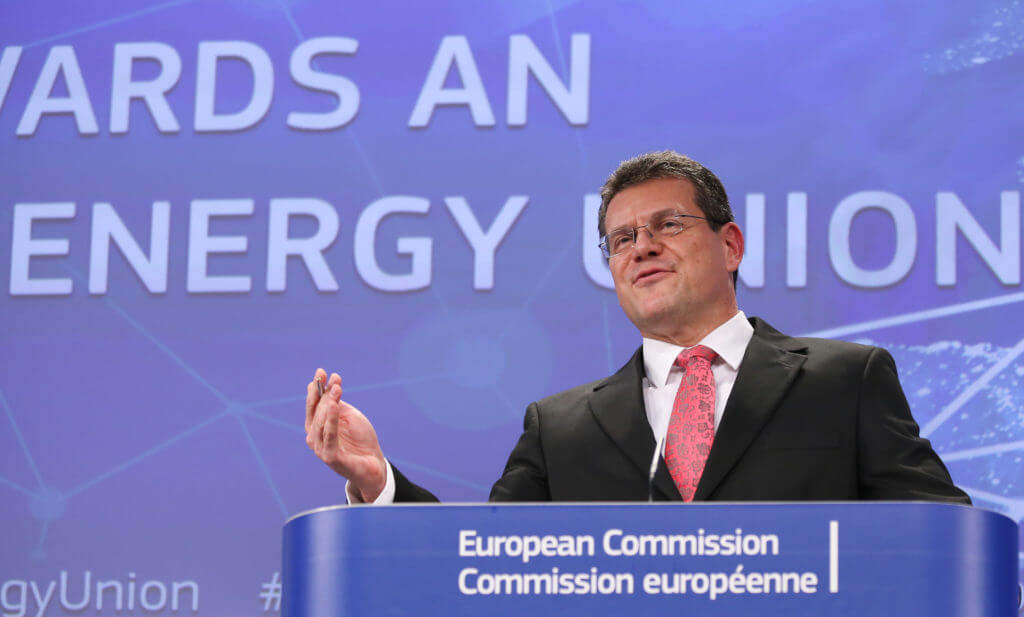
Christmas came early yesterday in Brussels, with the release of some heavy reading for the EU’s parliamentarians to digest over the festive season. Or at least that was the more jovial take on the launch of the EU winter package from Maroš Šefčovič, the EU vice-president in charge of the Energy Union (pictured).
Targets to cut energy use 30% by 2030, the phasing out of coal subsidies and regional cooperation on energy trading are central to the proposals, which updates the regulations and directives that support targets set out in 2014 as part of the Energy Package 2030.
Whether this gift is not just for Christmas will be down to the EU parliamentarians who have two years to debate these proposals and implement them.
So where does it leave us with the growth of renewables, the underpinning for a decarbonised power sector? If the EU meets its 2030 target, 50% of electricity should be renewable compared with an EU average of 29% today. That target remains unchanged, so those engaged in producing clean energy for Europe’s electricity grid should be reassured – up to a point.
A great deal was made of scrapping priority dispatch for renewables after that proposed change was ‘leaked’. In the end, the Commission merely soften its language but the outcome remains the same on priority dispatch, implying that policymakers think that renewable generation should be more responsive to the market.
Yesterday, Šefčovič and the Commissioner for Climate Action and Energy Miguel Arias Cañete both acknowledged that renewables need to be more integrated into wholesale markets, and those markets need to be more coordinated with each-other. Specifically, the package encourages member states to:
- ensure that renewables participate in wholesale and balancing markets on a “level playing field” with other technologies. In particular, the new package removes the requirement for renewables to be given priority dispatch over other generation types (which most, but not all, member states currently abide by). It instead requires dispatch which is “non-discriminatory and market based”, with a few exceptions such as small-scale renewables (<500kW). In addition, renewables should face balancing risk and participate in wholesale and balancing markets.
- increase integration between national electricity markets across the EU. Requirements include opening national capacity auctions to cross-border participation and an interconnection target of 15% by 2030 (ie, connecting 15% of installed electricity production capacity with neighbouring regions and countries). Earlier this year, the Commission established an expert group to guide member states and regions through this process.
What does this all mean for investors? The obvious concern is that removal of priority dispatch and exposure to balancing markets will increase revenue risk for renewables generators.
So, why is the EU removing these rules on priority dispatch once the mainstay of the Commission’s wholesale market rules? The main argument is to help reduce the costs of balancing supply and demand, and managing network constraints. Generally, it is most economic to dispatch renewables first because their running costs are close to zero regardless of whether they have priority dispatch.
But, when there is surplus generation, the most economic option is sometimes to curtail renewables ahead of other plant. For example, turning down an inflexible gas plant only to restart and ramp it up a few hours later can be expensive and inefficient. By contrast, wind generators can be turned down relatively easily.
Therefore, giving renewables priority dispatch can sometimes increase the overall costs of managing the system. When renewables were a small part of the market, any inefficiencies caused by priority dispatch were small and easy to ignore, while it helped reduce risks around renewables investment. But now renewables are set to become the dominant part of electricity markets it is harder to ignore.
Nevertheless, risks around balancing for wind can cause real headaches for investors. In our report from earlier this year, Policy and investment in German renewable energy we found that economic curtailment could increase significantly, potentially adding 17% to onshore wind costs by 2020.
The amount a generator is curtailed depends on a wide range of uncertain factors which wind investors have little or no control over (eg, electricity demand, international energy planning, network developments and future curtailment rules).
What could happen next?
So to maintain investor confidence (and avoid costly lawsuits) existing renewables investments need to be financially protected as rules are changed. There are many ways to do this. For example, priority dispatch status could be grandfathered for existing generators (as the winter package suggests) or, as set out in our recent report of Germany, generators could be fully compensated for curtailment through “take-or-pay” arrangements.
More generally, very clear rules around plant dispatch and curtailment are needed to avoid deterring investment. Ideally, dispatch will be determined by competitive, well-functioning balancing markets, where renewables are paid to be turned down based on what they offer, rather than by a central system operator curtailing without compensation.
The move to integrate renewables into balancing markets means they will compete with other options to balance the system such as storage and demand-side measures. These flexibility options should benefit from the sharper price signals and greater interconnection implied by winter package. But there is no clear consensus yet on the right business and regulatory models to support investment in flexibility. However, CPI is currently working on a programme as part of the Energy Transitions Commission to explore the role of flexibility in a modern, decarbonised grid and will be publishing our findings soon.
Ultimately, there is an unavoidable trade-off in designing electricity markets: it is very difficult to provide incentives for generators, storage and the demand-side to dispatch efficiently through market mechanisms without also exposing them to some risk. Yesterday’s announcement in the winter package means more countries will have to face this dilemma.
Disclaimer: Unless otherwise stated, the information in this blog is not supported by CPI evidence-based content. Views expressed are those of the author.

